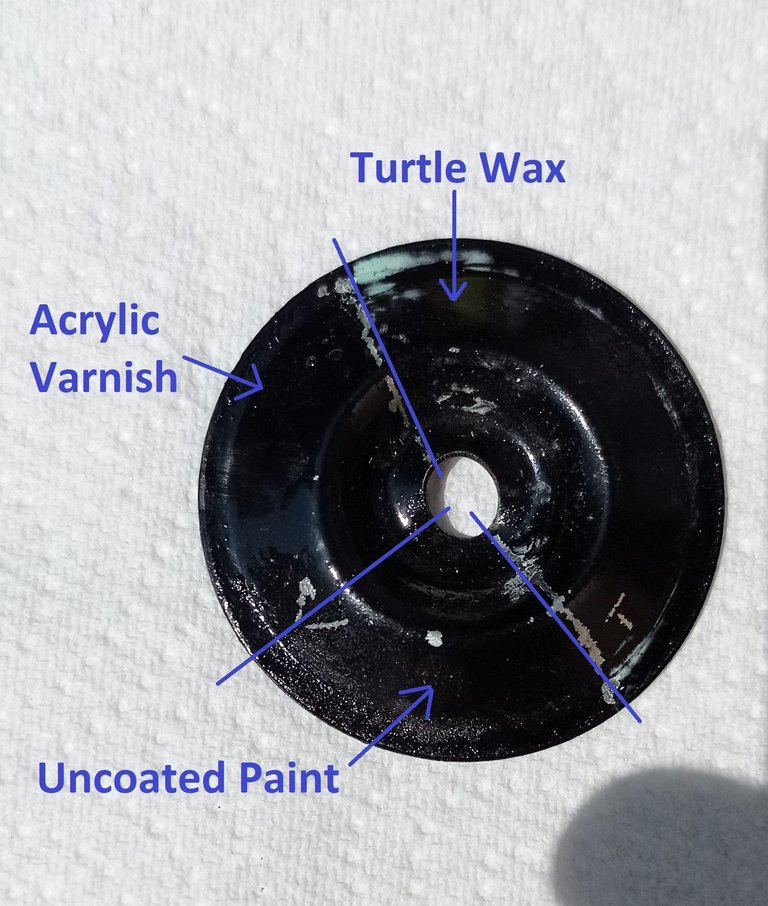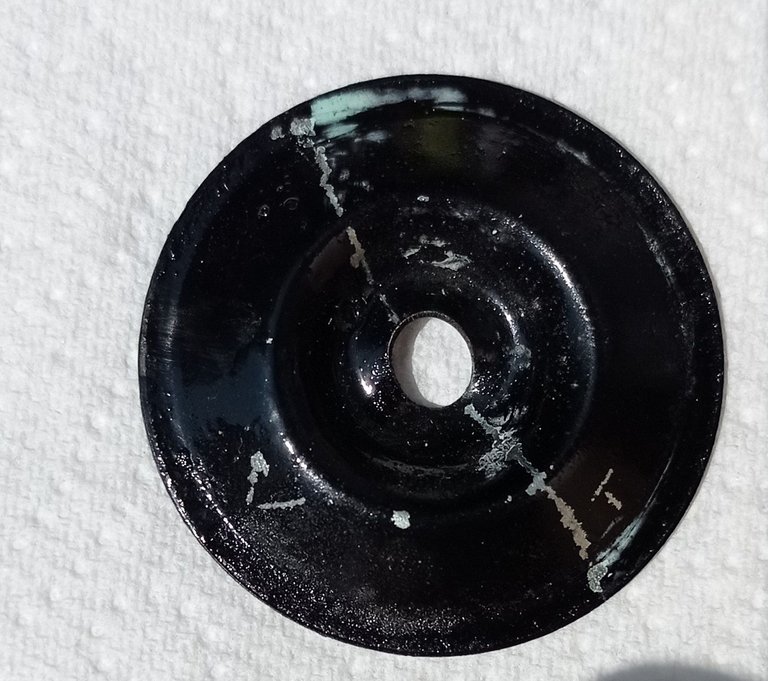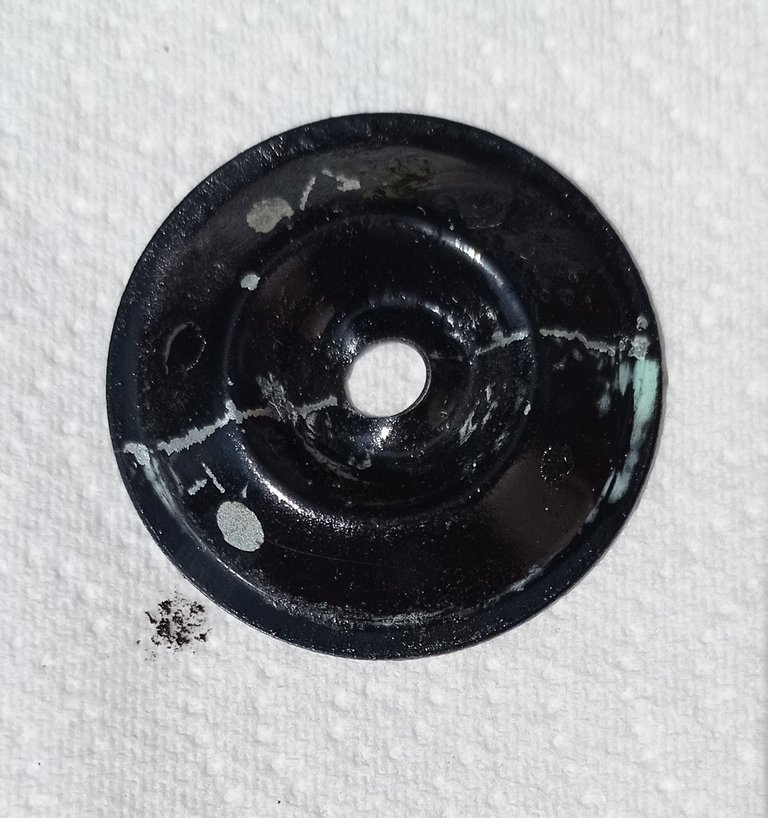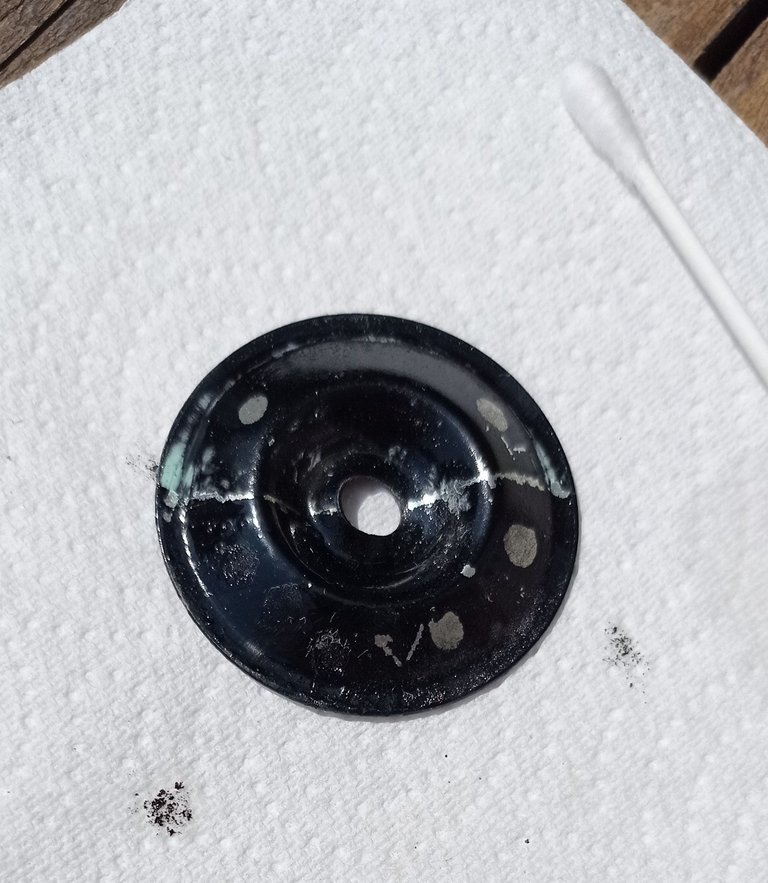Brake Fluid and Paint Experiment
I bought some paint recently which was marketed as "Brake Caliper Paint".
It was supposed to be a no-primer single coat caliper paint, but the main property listed on the label was that it was heat resistant. Despite being sold as a paint for brake calipers, there was no mention in the small print about it being resistant to brake fluid, and that definitely turned out to be a problem.
The paint sprayed on beautifully. However, the no-primer aspect wasn't strictly true; despite being very careful with preparation of the underlying metal, the paint still scratched and chipped too easily once it was dry, and it's clear that it was a strong surface layer rather than chemically bonded to the underlying surface.
The real problem was that a single drop of brake fluid escaping from the bleed nipple when I bled the brakes ruined the finish. As you can see from the photo below, it ran down the front of the caliper. I wiped it off within a couple of seconds and it took the paint with it.

I was pretty upset with this, so I decided to do an experiment to test how good the paint actually was and whether there was anything I could do to improve the situation.
Preparation for the experiment
I sprayed an old damaged brake pad retaining plate (the first chunk of spare metal I had to hand), gave it a couple of weeks for the paint to fully cure through, then applied protective treatments to two areas to see what worked best.
The photo below shows the plate at that point. Don't worry about the finish; the underlying metal was rusty, so all I did was sand it to get back to clean bare metal, so the surface was quite rough. It's the paint I'm concerned about, and how resistant it is to brake fluid.
Although I scratched lines and marks into the surface so I knew which areas had been treated, it's noticeable that some parts chipped just with handling, showing the poor bond the paint makes to the metal.
Half of the plate received two coats of Turtle Wax (normally used to polish and protect car paintwork), and the other half was split between no treatment, and two coats of acrylic varnish. I didn't have an automotive one handy so I used Vallejo Gloss Acrylic Varnish, which is mostly used by model makers.

Ready for the experiment ! DOT4 brake fluid, paper kitchen towel, painted plate and cotton buds.

By this stage, the paint had been on for about a month and the varnish for over a week. It always takes time for surface coatings to cure through thoroughly and gain their full strength, but I felt this was an adequate time for the purposes of this test.
The 10 Second Test
For the first test, I used a cotton bud to put a drop of brake fluid on each surface. Then I counted to ten and wiped them off with kitchen towel.
It's hard to see from the photo below, but the varnished surface had some softening going on and wiping it left a slight mark that would end up matt. The untreated paint had a similar effect but to a lesser extent. Interestingly, the brake fluid drop on the Turtle Wax beaded up in the same way water does on a waxed surface and wiped off with no problem.

The 5 Minute Test
Note that the plate is rotated in this image compared to others !
After 5 minutes, the results looked very different. When I wiped both the untreated and Turtle Waxed surfaces, it just took the paint off completely. For both these surfaces you can also just see where the final (10 minute) drop is starting to eat into the paint.
The varnish, after a worrying start, did far better. You just can see where the brake fluid is starting to eat into the surface, but when it was wiped it left a bit of a smear but didn't go all the way down to the metal.

The 10 Minute Test
The final test was to do another wipe after 10 minutes. Note that in all cases, I'm wiping gently, not aggressively.
As expected, the Turtle Wax and untreated surfaces totally failed. The varnished surface was close to the point of failure with a small amount of the underlying metal surface starting to show, but even though it would leave a permanent mark it still performed far better than the other finishes.
Both the spots on the varnished surface were significantly softened and slightly sticky.

Conclusion
Brake Caliper Paint is rubbish. I don't know what Kawasaki used when they originally painted the caliper back in 1978, but it was far superior to modern formulations.
Sadly, my day job involves paint, and I've seen endless regulations (mainly originating from the EU) restricting what manufacturers can use in paint. It's nominally for safety, but the end result is that modern paints are very poor in terms of their strength, durability and bonding performance compared to paints from 20 or more years ago.
In this case, the only surface which gave me some hope was the varnished one. A run of brake fluid would still leave an ugly mark, but at least it wouldn't strip the paint straight off.
The two spots on the varnish were soft after the experiment and would be easily damaged if touched before they had the chance to re-set, but I suspect this wouldn't be so bad if any spill was wiped straight off with a damp cloth and then washed down with plenty of cold water.
I might do some experiments with automotive-specific acrylic and polyurethane varnish to see if there are ones which are more resistant than Vallejo's. I suspect the Vallejo varnish might not have the heat resistant properties needed for permanent application, although to be fair it's a vintage bike which I don't ride like a hooligan (any more) so the brakes are unlikely to get ridiculously hot.
I've got a spare caliper which I painted at the same time, so I can varnish that and swap it onto the bike, then re-do the first caliper with primer as well to improve resilience.
Classic marketing BS, no primer needed but then it peels off with one drop of brake fluid. Chemistry doesn't lie, proper prep always wins. Thanks for the real world test man
Yeah - I'm not sure how much difference a primer would have made. If the brake fluid can eat the paint it'll still look a mess even if the primer is undamaged. But I think they should have marketed it as high temperature paint rather than caliper paint !
yes yes exactly, high temperature paint